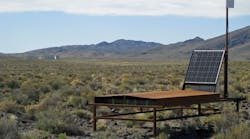The University of Utah is planning a $6.4 million expansion of its $25 million Telescope Array observatory so physicists can zero in on a “hotspot” that seems to be a source of the most powerful particles in the universe: ultrahigh-energy cosmic rays.
Japan will contribute $4.6 million and University of Utah scientists will seek a $1.8 million from the National Science Foundation to nearly quadruple the size of the existing 300-square-mile cosmic ray observatory in the desert west of Delta, Utah. Japan’s funding is approved and a decision on the University of Utah’s grant request is expected early in 2016.
The expansion will help scientists identify which objects in space produce ultrahigh-energy cosmic rays. The university describes these subatomic particles as so energetic that just one would feel like a lead brick if it hit your foot or a fast-pitched baseball to the skull. The rays are unable to penetrate the Earth’s atmosphere.
“We know these particles exist, we know that they are coming from outside our galaxy and we really don’t have a clue as to how nature pumps that much energy into them,” says Pierre Sokolsky, a University of Utah professor of physics and astronomy. “In order to have a clue, we need to know where they are coming from. This hotspot is our first hint. We need to work with astronomers and find out what galaxies or black holes are in this hotspot.”
The array now has 507 detectors spaced in a grid over 300 square miles of desert. The expansion will add two lobes containing 400 more detectors to the array’s footprint, so it will expand to almost 1,000 square miles. The planned expansion would make the Telescope Array in Utah almost as large and sensitive as the Pierre Auger cosmic ray observatory in Argentina.


